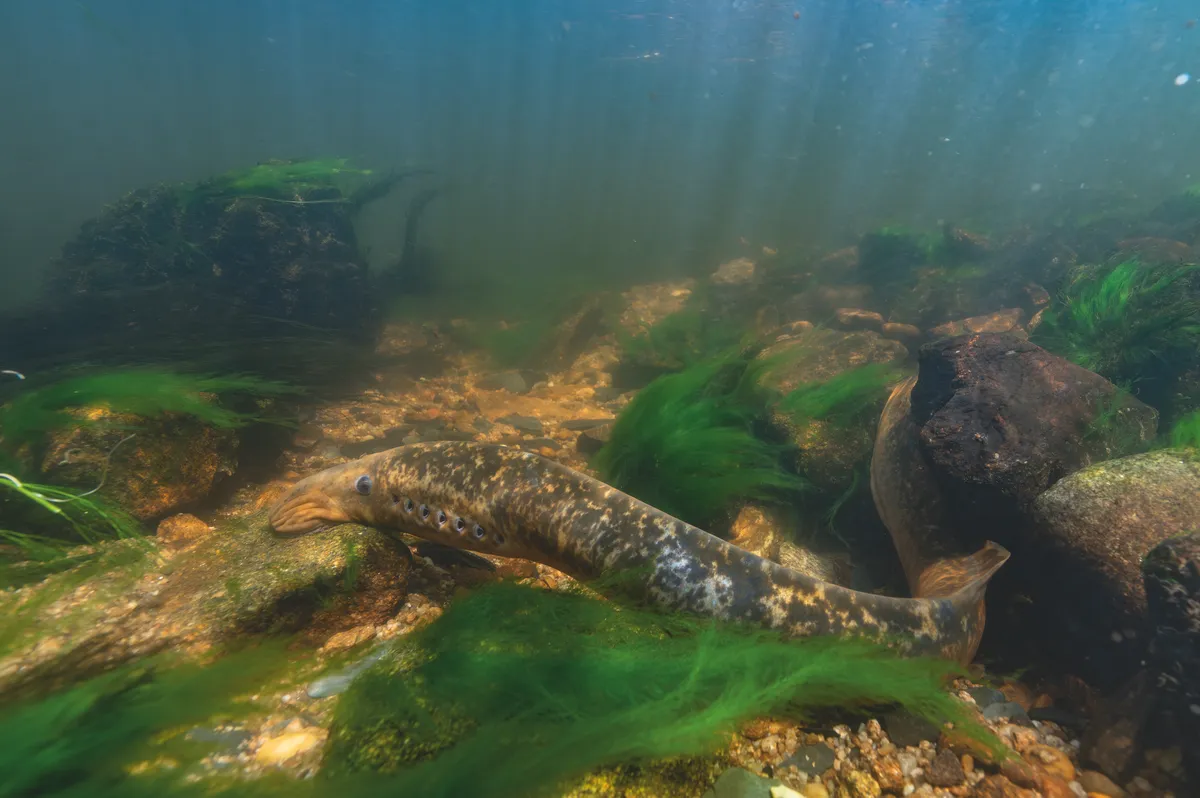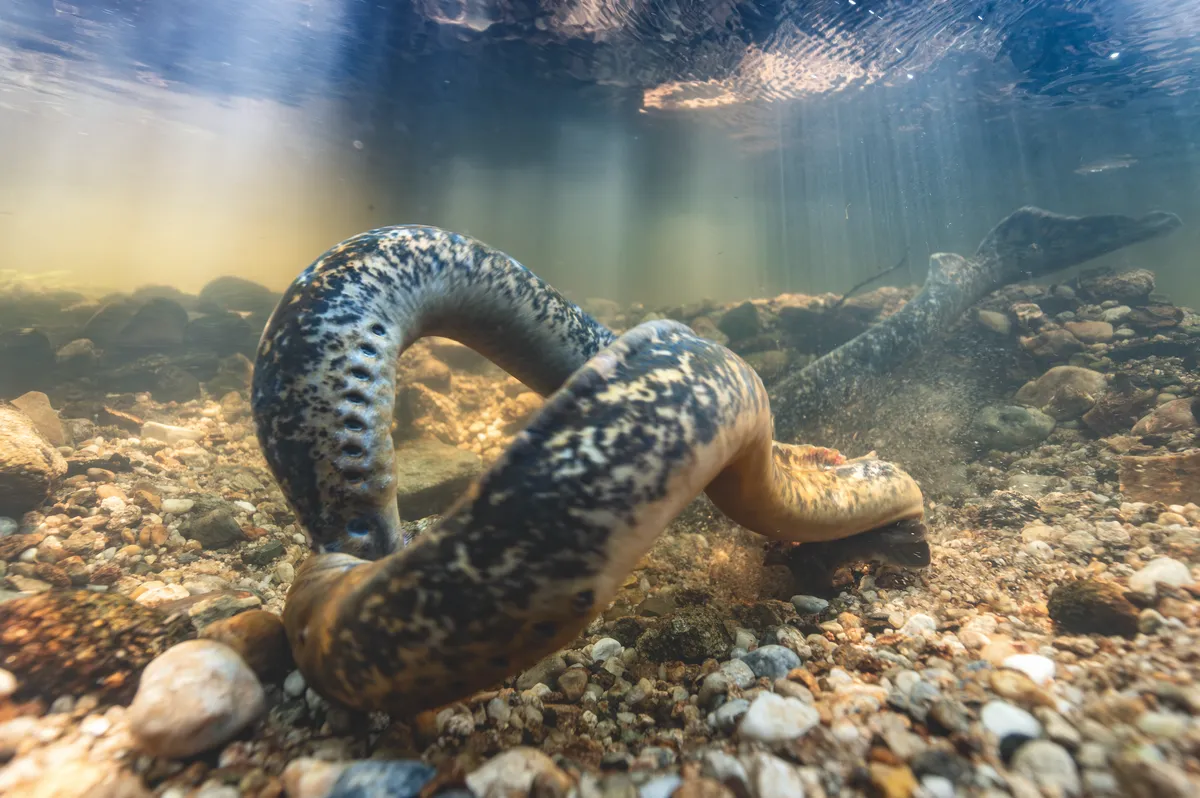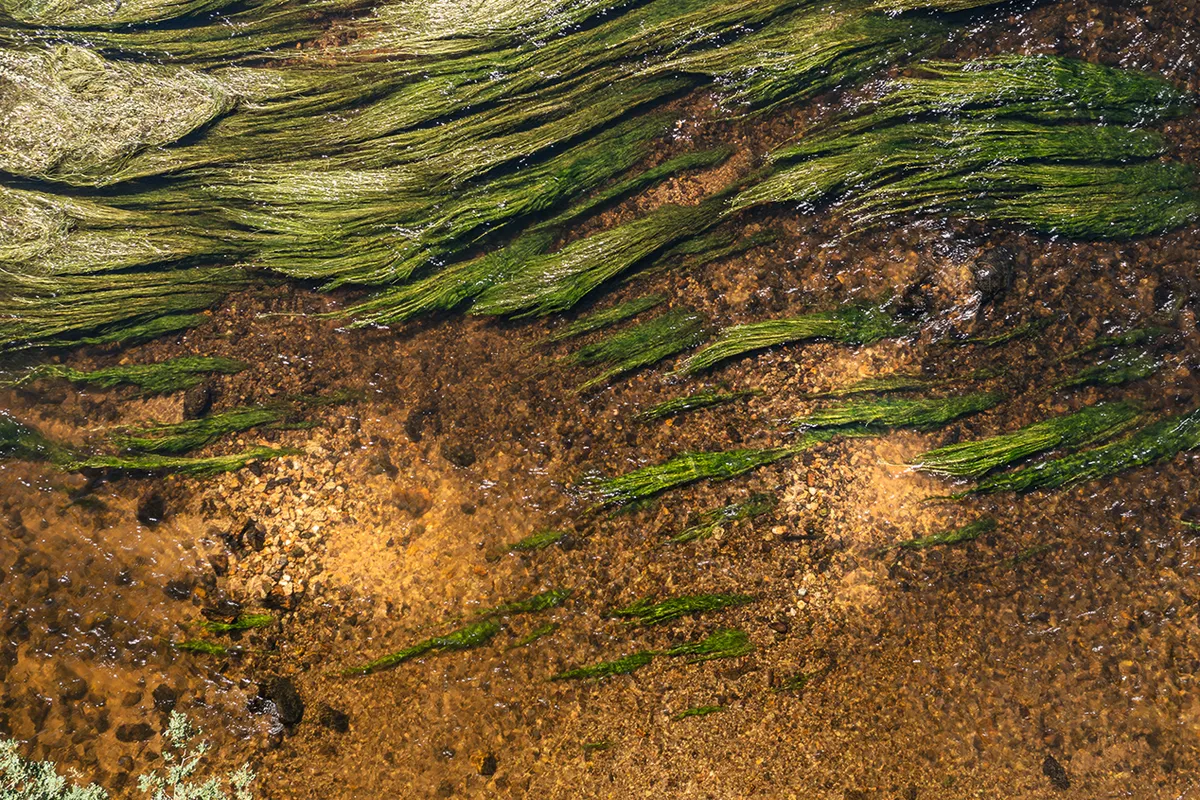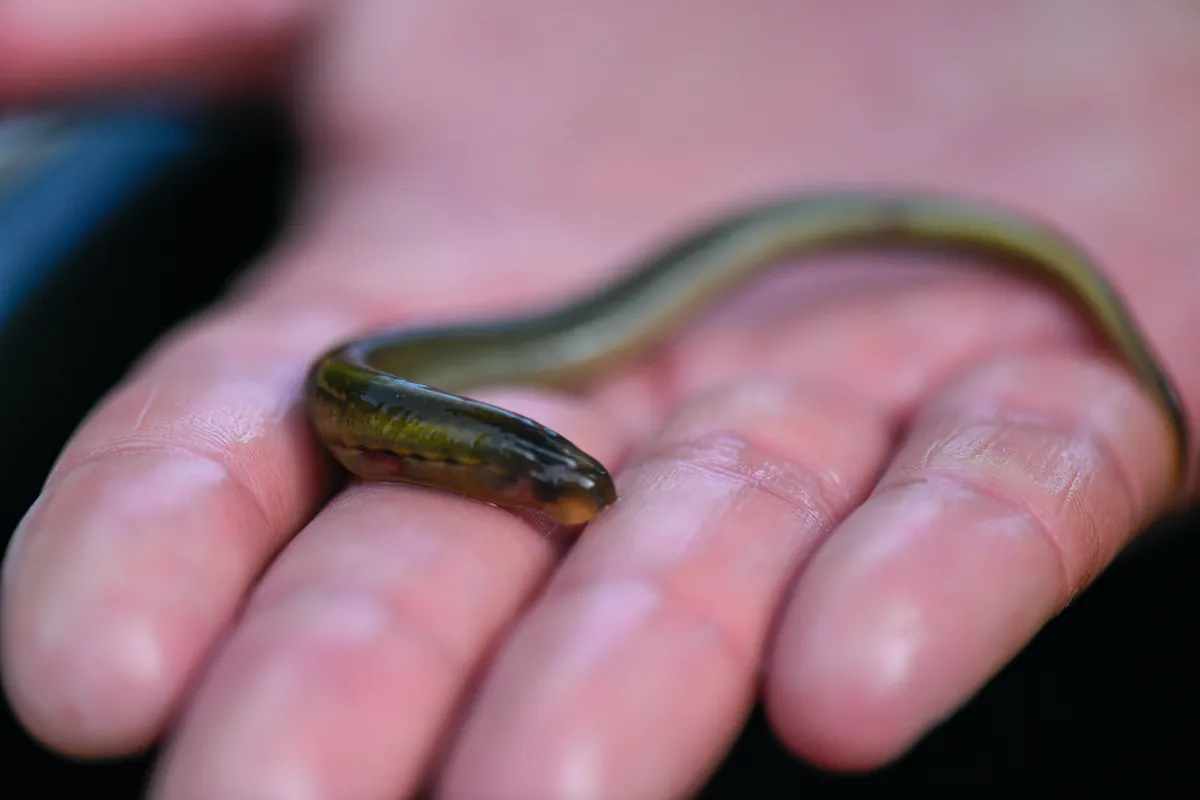The sea lamprey is a most peculiar fish. It has a slimy, eel-like body and an alien-like mouth, and is a parasite, latching onto other creatures to feed. It first appeared 300 million years ago, making it more ancient than the dinosaurs.
Admittedly, all told, the sea lamprey is not a creature with mass appeal, yet there is something about this bizarre species – one of three lamprey species found in France– and its extraordinary life-cycle that fascinates me. I’ve always had an insatiable curiosity for the natural world, and even though I work in freshwater management and restoration, I spend most of my spare time travelling around France with my wife, Aurore, in search of emblematic, rare or threatened river species to photograph.
When I chose to focus on the sea lamprey, I got all three. A desire was kindled to uncover the secrets of this enigmatic, watery creature that has survived four major extinction events. But this is not an easy fish to find. The river-dwelling juveniles bury themselves in the sediment, and the adults migrate into the sea, out of sight. Only the months of May and June, when the adults swim home to breed, offer the chance of an encounter.
- Bobbit worm, a terrifying 3 metre marine worm that can cut its prey in half
- Weirdest sea creatures - meet 12 strange sea creatures of the deep
- Weirdest fish: 12 of the strangest fish in the world

The first thing you notice about a sea lamprey is its remarkable mouth. It’s a perfectly round, sucker-like disc, wider than its body and lined with concentric rings of pointy little teeth.
It expertly uses this appendage to attach itself to other fish and marine mammals, piercing their flesh with its file-like tongue to feed on their fluids, a habit that has given rise to colourful monikers such as ‘vampire eel’ and ‘eelsucker’. This grisly behaviour is rarely documented as it occurs only among the sea-dwelling adults.
The youngsters grow and develop for three to eight years before making their journey to the sea.
I had always wanted to witness the sea lamprey’s remarkable journey from the open ocean to its freshwater breeding grounds, but living in the south-east of France, in the Rhône-Mediterranean basin, I never had the chance, as the species has all but disappeared from the region. Aurore and I have spent many a weekend knee-deep in both slow-moving rivers and rushing streams, and have chanced upon many other fascinating species, including the viperine water snake, European eel and beaver, and even rarities such as the Hérault ray-finned fish and blue crayfish. But the sea lamprey always remained elusive.

Then, life took us north to Paris. Suddenly, I was in much closer reach of my quarry, and the quest could begin in earnest. First, I hit the books and the internet. I needed to learn the types of stream and temperatures lampreys preferred, the best times to see them and whether they were nervous around humans. I studied data on breeding sites from previous years and, using Google Maps, identified potential new sites that would also offer promising conditions for photography.
After hours of research, I decided to try my luck in a small Normandy village a 90-minute drive away. May had rolled around and we headed straight to the riverbank. After hours upon hours prospecting in the clear water, I came across some nests but not a single lamprey. Knowing the creatures were present, I kept up the search, but the fish stayed stubbornly out of sight.

I turned to biologists and sea lamprey enthusiasts for help. They advised me to try the Creuse, a river in central France known as a lamprey hotspot. Aurore and I arrived to discover a peaceful place, an amber-coloured river flanked by tall trees. Walking along its banks and peering into its tumbling waters, serenaded by yellow orioles and European bee-eaters, we felt alone in the world.
However, our adventure didn’t go quite to plan. The Creuse was in flood and it was very difficult to manoeuvre in the fast-moving water, let alone search properly for lampreys, and we only managed fleeting glimpses of a few lone males. Pulling on my mask and snorkel, I attempted to take some pictures, but such was the torrent that Aurore had to pin me down underwater, using every ounce of her strength to stabilise me for the few seconds needed to click the shutter. We tried again and again but were repeatedly caught in the current and swept away, and narrowly avoided smashing our photography gear on the rocks.
It was the most exhausting shoot we have attempted, yet I was overjoyed to have finally seen this weird little fish in the flesh. The desire to complete my quest burned even stronger, but with the Creuse proving too difficult and dangerous, I needed to try another location.
Then, a stroke of luck. I met some fishermen participating in a study on porbeagle sharks off the coast of Brittany. They were able to advise me of some other places where weaker currents and lower water levels might offer prime conditions for lamprey photography.
Aurore and I have spent many a weekend knee-deep in both slow-moving rivers and rushing streams.
And so Aurore and I headed west. We checked into a hotel beside the River Laïta, a convergence of the rivers Isole and Ellé, and I peered out of the window. To my astonishment, in the water below, I immediately spotted several sea lampreys, their unmistakable slender bodies wriggling through the water. Finally, the right place and right time.
Because Brittany is a peninsula, returning sea lampreys have less distance to travel inland and fewer obstacles to overcome, which makes this region one of the few places remaining in France where you can observe these fish with relative ease. Populations have collapsed throughout their range due to climate change (warmer water affects reproduction rates and decreases oxygen concentration; disruption of the water cycle, due to flooding and drought events, impacts migration) and human encroachment on their habitat. In the Loire catchment, for example, virtually no sea lampreys have been recorded in recent years, a contrast to the tens – even hundreds – of thousands that filled these waters prior to the industrial era and the construction of dams. Even in the relative stronghold of Brittany, numbers have declined dramatically. The sea lamprey is thus classified as Endangered in France by the IUCN.

With a location finally in the bag, our next task was to pinpoint a breeding territory. In breeding season, male lampreys release a pheromone to attract a female, and start the process of building a nest, which takes the form of a clean, circular patch of riverbed. If he successfully couples up, the pair finish the job together, using their oral discs to clear stones and pebbles, and relying on the current to carry away any remaining gravel and other smaller stones. Only when the dwelling is ready will mating take place between the two.
Using bridges and other vantage points, we looked for ‘riffles’ – shallow, rocky areas that interrupt the water flow. Riffles are sought after as nest-sites because they have higher levels of oxygen, which is essential for the development of lamprey eggs and young. If we spotted a riffle, the next step was to identify a conspicuous circle guarded by a dark, elongated shape.

It took just an hour or so to find what we were looking for. I wriggled into my wetsuit while Aurore, who didn’t fancy a dip in the chilly water, clambered into her waders. We quickly discovered a few lone males, recognisable by their prominent dorsal ridges, busily clearing pebbles as they awaited the females, and I took full advantage of the chance to photograph the species without the risk of drowning.
After a few days happily immersed in lamprey life, we came across a nest inhabited by a trio – two females and a male (males nesting with multiple females is not uncommon). The females were adding the finishing touches to ensure optimum comfort for their offspring.
Then came the business of spawning. To show that she is receptive, a female clings to a large rock. Taking his cue, the male attaches his mouthparts to her head, surrounds her body and presses on her belly. As thousands of eggs are released, he expels his sperm and fertilizes the eggs, which settle in the fine substrate of the nest. The event is over in an instant, so when one of ‘our’ females announced herself, I had to be very quick to capture the moment. Luckily, the ritual was repeated many times, as females release their eggs – up to 600,000 of them – over several mating attempts. So enthusiastic was the male that at one point the female’s rock toppled over, and the couple was swept downstream in full mating action.

We didn’t stay long enough to find out, but the male would probably have mated with the second female too, provided he had sufficient strength. Mating is incredibly strenuous, and all adults die afterwards. Indeed, we later came across many corpses washed up on riverbanks downstream. Macabre though this was, it enabled us to observe the species close-up: mottled skin covered with mucus; seven branchial pores (used for breathing when the mouth is in cling-on mode) on the sides of the head, and a single central nostril. A strange animal indeed.
Early life as a sea lamprey is nothing if not perilous. From their first days, they face a host of predators, including young salmon, vast shoals of minnows and some miller’s thumb, which lurk downstream of lamprey nests, ready to dine on any eggs that are washed away. No wonder the tiny juveniles, which hatch after 10-15 days, stay out of sight, safely hidden in the sediment. To feed, they filter water using branchial pores, eating the microorganisms, algae and organic debris left behind. As such, water quality is essential to their survival: pollution or low oxygen levels triggered by high temperatures can be catastrophic.
The first thing you notice about a sea lamprey is its remarkable mouth. It’s a perfectly round, sucker-like disc, wider than its body and lined with concentric rings of pointy little teeth.
And here the youngsters stay, growing and developing for three to eight years before making the journey to the sea. Their sojourn in the marine world lasts for about two years, after which the adults return home to reproduce. The final challenge is navigating weirs en route to their spawning ground. Any feature – a sluice, hydroelectric dam or mill – that causes a sudden increase in water level limits the movement of all migratory species. It is estimated that there are nearly 100,000 across France, but fortunately a policy of restoring ecological continuity is now in place. Installing fish-passes, reducing weirs in height and removing them altogether is helping to prevent further population collapse.
Aurore and I have spent many long hours on the banks of French rivers, each time encountering animals more astonishing than the last. For a long time, I believed that I would never manage to observe the living fossil that is the sea lamprey, nor witness its incredible life-cycle. At a time when biodiversity is faltering, I feel privileged to have been able to observe both. Entering the intimate world of the sea lamprey and finding a river where its population is doing well gives me hope. When we combine our awareness of environmental issues with the resilience of ecosystems, it is possible to achieve great things.
Turning the tide
Sea lamprey populations are collapsing in France, but this is not the case everywhere. Canada has experienced a massive influx of sea lampreys since the 1920s. There, sea lampreys have adapted and, instead of swimming from rivers to the Atlantic Ocean, they head for the Great Lakes, where they target large fish such as trout and sturgeon. In the ocean, a host does not usually die from lamprey parasitism, but this is not the case in the lakes – many fish die following lamprey attack. This has had a considerable impact on the Great Lakes Fishery Commission, sparking the creation of a control programme.
Lamprey life
There are about 40 species of lamprey around the world. Ten species are found in Europe and of these, three – the sea, river and brook – are found in France. The same three also occur in the UK. Sea and river lampreys are born in rivers and migrate to the sea as adults, then, after one to two years, return to their natal rivers to breed. The brook lamprey, in contrast, spends its entire life in freshwater, and unlike both its cousins, is not a parasite.
Want to find out more?
For more fascinating facts, check out our in depth guide to lampreys. And if you're intrigued about the weird and wonderful creatures that lurk in the underwater realm, we have a huge collection of marine animal guides, from the terrifying bobbit worm to the mysterious vampire squid.